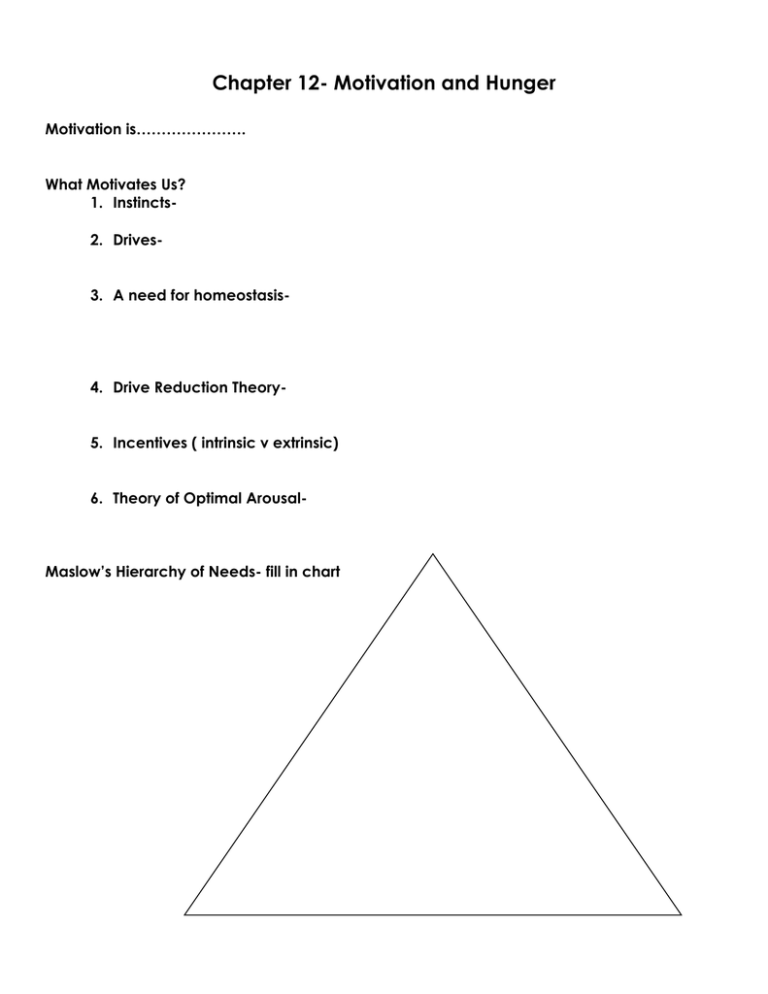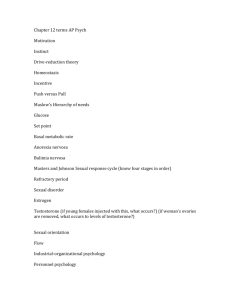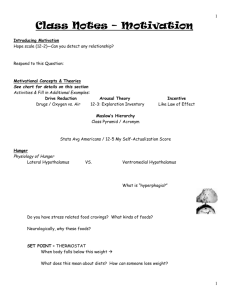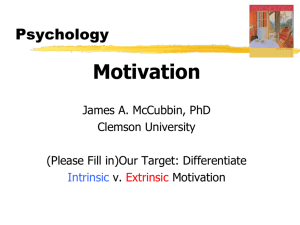
Chapter 12- Motivation and Hunger
Motivation is………………….
What Motivates Us?
1. Instincts2. Drives3. A need for homeostasis-
4. Drive Reduction Theory5. Incentives ( intrinsic v extrinsic)
6. Theory of Optimal Arousal-
Maslow’s Hierarchy of Needs- fill in chart
What does it mean to be self- actualized?
Why am I So Hungry?
1. Physiological reasons for hunger- know the Walter Cannon Study
2. Chemicals are unbalanced- How do the following influence hunger?
a. Glucoseb. Insulinc. Leptin3. Neurotransmitters are unbalanced- Know how they influence hunger.
a. Norepinephrineb. Dopaminec. Serotonin4. Hypothalamus – know how they each influence hunger.
a. Lateral Hypothalamus
b. Ventromedial Hypothalamus
5. Hunger Hormones- How do the following influence hunger?
a. Insulinb. Orexinc. Ghrelind. PYYHow does Hunger affect my life?
1. Set Point2. Basal Metabolic Rate ( Metabolism)3. Memory and Hunger4. Modeling5. Anorexia6. Bulimia-
Chapter 12- Motivation and Sex
Sex
1. Major Researchers
1. Alfred Kinsey- Know the study and why it is important?
2. Masters and Johnson Sexual Response Cycle1.
2.
3.
4.
ExcitementPlateauOrgasmResolution and Refractory period-
2. Hormones and Sex- How do the following influence our sexual behaviors?
1. Estrogen2. Testosterone3. Hypothalamus3. External Stimuli and Sexual Motivationa. Julia Heiman Studyb. How do men and women compare in terms of sexual motivation?
4. Sexual Disorders1. Premature Ejaculation2. Impotence3. Orgasmic Disorder5. Why do Teens get Pregnant?
6. What “causes” homosexuality?
a. Nature Supportedb. Nurture Supported-
Chapter 12- Motivation and Work
7. Motivation- The need to Achieve1. Intrinsic v Extrinsic- what’s the difference?
2. Achievement Motivation- page 491-
8. The Art of Motivating People1. Industrial- Organizational Psychology-
2. Personnel Psychology-
3. Organizational Psychology-
4. Task Leadership vs. Social Leadership-
5. Theory Y vs. Theory X
1. Which of the following is clearly not an example of an incentive?
A) $1000
D) smell of popcorn
B) threat of punishment
E) lack of bodily fluids
C) electric shock
2. Motivation is defined by psychologists as:
A) an impulse to accomplish something of significance.
B) rigidly patterned behavior characteristic of all people.
C) a need or desire that energizes and directs behavior toward a goal.
D) the cause of behavior.
3. The set point is:
A) the stage of the sexual response cycle that occurs just before orgasm.
B) the body temperature of a healthy organism, for example, 98.6 degrees F in humans.
C) the point at which energy expenditures from exercise and from metabolism are equal.
D) the specific body weight maintained automatically by most adults over long periods of time.
4. The arousal theory of motivation would be most useful for understanding the aversive effects of:
A) refractory periods.
D) boredom.
B) sexual disorders.
E) anorexia nervosa.
C) hunger.
5. The most basic or lowest-level need in Maslow's hierarchy of human motives includes the need
for:
A) self-esteem.
D) food and drink.
B) love and friendship.
E) achievement.
C) religious fulfillment.
6. With regard to the incidence of premarital sexual intercourse among Americans
during the 1940s, Alfred Kinsey found that:
A) nearly all men and most women reported having premarital sexual intercourse.
B) most men and nearly half the women reported having premarital sexual intercourse.
C) most men but very few women reported having premarital sexual intercourse.
D) very few individuals of either sex admitted having premarital sexual intercourse.
7. Increases in ________ increase hunger, whereas increases in ________ decrease
hunger.
A) insulin; blood glucose
C) leptin; orexin
B) blood glucose; leptin
D) orexin; insulin
8. If researchers wanted to improve upon the scientific accuracy of Alfred Kinsey's
research on American sexual practices, their first concern should involve:
A) using telephone rather than face-to-face interviews.
B) interviewing a larger number of people.
C) having females rather than males interview the female respondents.
D) interviewing a more representative sample of the American population.
9. The brain structure that detects sex hormone levels and activates sexual arousal is
the:
A) cerebellum. B) amygdala. C) hypothalamus. D) medulla. E) thalamus.
10.
For a thirsty person, drinking water serves to reduce:
A) homeostasis.
D) the refractory period.
B) a drive.
E) metabolic rate.
C) an instinct.
11. Mice are most likely to eat less when they experience ________ levels of ________.
A) elevated; leptin B) reduced; glucose C) elevated; orexin D) reduced; ghrelin
12. When an organism's weight rises above its set point, the organism is likely to experience a(n):
A) decrease in both hunger and basal metabolic rate.
B) increase in hunger and a decrease in basal metabolic rate.
C) decrease in hunger and an increase in basal metabolic rate.
D) increase in both hunger and basal metabolic rate.
13. Research on the environmental conditions that influence sexual orientation indicates that:
A) homosexuals are more likely than heterosexuals to have been sexually abused during
childhood.
B) homosexuals are more likely than heterosexuals to have been overprotected by their
mothers.
C) homosexuals are more likely than heterosexuals to have been raised in a father-absent
home.
D) homosexuals are more likely than heterosexuals to have been exposed to a gay or lesbian
schoolteacher.
E) the reported backgrounds of homosexuals and heterosexuals are similar.
14. About eight months ago, 14-year-old Shelley went on a drastic weight-loss diet that caused
her to drop from 110 to 80 pounds. Although she is now dangerously underweight and undernourished, she continues to think she looks fat. Her frustrated father recently forced her to eat a
peanut butter sandwich, but Shelley immediately went to the bathroom and threw it all up.
Shelley most clearly suffers from:
A) excess leptin.
D) hypermetabolism.
B) an abnormally low set point.
E) anorexia nervosa.
C) bulimia nervosa.
15. Anorexia patients are most likely to have parents who:
A) have physically or sexually abused their children.
B) are high-achieving and protective.
C) have been recently separated or divorced.
D) are unconcerned about physical appearance and body weight.
16. Theory Y managers are more likely than Theory X managers to:
A) frequently monitor individual employees in order to make sure they are working.
B) discourage employees from critically discussing controversial company policies.
C) give employees a high degree of responsibility for developing their own work procedures.
D) remind employees of the exact deadlines for the completion of work projects.
17. Which profession is most directly involved in the application of psychology's principles to the
workplace?
A) social psychology
D) developmental psychology
B) personality psychology
E) industrial-organizational psychology
C) cognitive psychology
18. Developing assessment tools for selecting and placing employees is of most direct relevance to:
A) social psychology.
D) human factors psychology.
B) clinical psychology.
E) personnel psychology.
C) organizational psychology.
19. After studying artists who would spend hour after hour painting or sculpting with enormous
concentration, Csikszentmihalyi formulated the concept of:
A) a hierarchy of motives.
D) 360-degree feedback.
B) erotic plasticity.
E) flow.
C) achievement motivation.
20. Participative management is to _______ as directive management is to ________.
A) leniency errors, halo errors
B) Theory Y; Theory X
C) task leadership; social leadership
D) unstructured interviews; structured interviews
21. Dr. Thompson is involved in scripting interview questions that will effectively predict job
applicants' success in specific work positions. Her work best illustrates that of a(n) ________
psychologist.
A) personnel B) organizational C) human factors D) clinical
22. According to Maslow, our need for ________ must be met before we are preoccupied with
satisfying our need for ________.
A) love; food
D) self-actualization; friendship
B) adequate clothing; self-esteem
E) political freedom; economic security
C) religious fulfillment; adequate housing
23. Dr. Milosz electrically stimulates the lateral hypothalamus of a well-fed laboratory rat. This
procedure is likely to:
A) cause the rat to begin eating.
B) decrease the rat's basal metabolic rate.
C) facilitate conversion of the rat's blood glucose to fat.
D) permanently lower the rat's set point.




